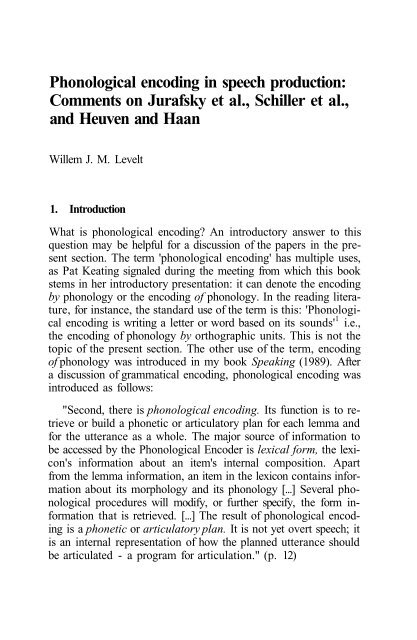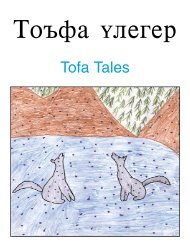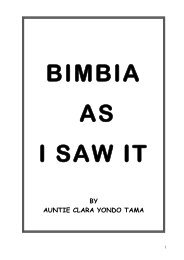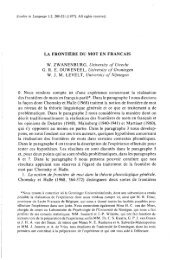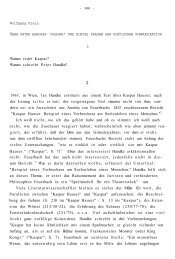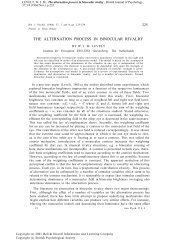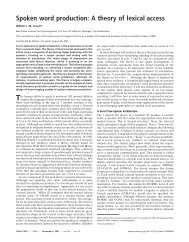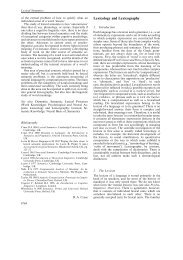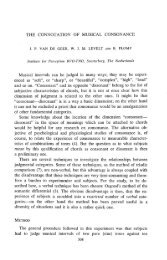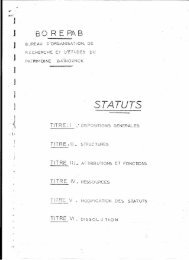Phonological encoding in speech production: Comments on ...
Phonological encoding in speech production: Comments on ...
Phonological encoding in speech production: Comments on ...
You also want an ePaper? Increase the reach of your titles
YUMPU automatically turns print PDFs into web optimized ePapers that Google loves.
2 Willem J. M. LeveltIntroduc<str<strong>on</strong>g>in</str<strong>on</strong>g>g this use of the term to denote the speaker's ph<strong>on</strong>ologicalpreparati<strong>on</strong> of the utterance was by no means <str<strong>on</strong>g>in</str<strong>on</strong>g>troduc<str<strong>on</strong>g>in</str<strong>on</strong>g>g thestudy of this process. Clearly, the study of ph<strong>on</strong>ological <str<strong>on</strong>g>encod<str<strong>on</strong>g>in</str<strong>on</strong>g>g</str<strong>on</strong>g>has its roots <str<strong>on</strong>g>in</str<strong>on</strong>g> <str<strong>on</strong>g>speech</str<strong>on</strong>g> error analysis, go<str<strong>on</strong>g>in</str<strong>on</strong>g>g back as far as Mer<str<strong>on</strong>g>in</str<strong>on</strong>g>gerand Mayer's (1895) careful analysis of form errors <str<strong>on</strong>g>in</str<strong>on</strong>g> sp<strong>on</strong>taneous<str<strong>on</strong>g>speech</str<strong>on</strong>g>. They dist<str<strong>on</strong>g>in</str<strong>on</strong>g>guished between mean<str<strong>on</strong>g>in</str<strong>on</strong>g>g-based substituti<strong>on</strong>s(such as Ihre for me<str<strong>on</strong>g>in</str<strong>on</strong>g>e) and form-based substituti<strong>on</strong>s (such as Studienfor Stunden), which suggested the existence of two levels ofprocess<str<strong>on</strong>g>in</str<strong>on</strong>g>g <str<strong>on</strong>g>in</str<strong>on</strong>g> <str<strong>on</strong>g>speech</str<strong>on</strong>g> <str<strong>on</strong>g>producti<strong>on</strong></str<strong>on</strong>g>, <strong>on</strong>e of which c<strong>on</strong>cerns form <str<strong>on</strong>g>encod<str<strong>on</strong>g>in</str<strong>on</strong>g>g</str<strong>on</strong>g>.This noti<strong>on</strong> was elaborated <str<strong>on</strong>g>in</str<strong>on</strong>g> much detail by Garrett(1975). He discovered that word exchanges (such as he left it andforgot it beh<str<strong>on</strong>g>in</str<strong>on</strong>g>d) can be between phrases or clauses, but preservesgrammatical category and grammatical functi<strong>on</strong>. By c<strong>on</strong>trast,sound exchanges (such as rack pat for pack rat) mostly happenbetween juxtaposed or close-by words, which can differ <str<strong>on</strong>g>in</str<strong>on</strong>g> grammaticalcategory and functi<strong>on</strong>. Apparently two levels of process<str<strong>on</strong>g>in</str<strong>on</strong>g>gare <str<strong>on</strong>g>in</str<strong>on</strong>g>volved <str<strong>on</strong>g>in</str<strong>on</strong>g> utterance generati<strong>on</strong>, which Garrett called the'functi<strong>on</strong>al' and 'positi<strong>on</strong>al' levels. The latter <str<strong>on</strong>g>in</str<strong>on</strong>g>volves morphologicalprocesses such as affixati<strong>on</strong> and all further ph<strong>on</strong>ological(though not ph<strong>on</strong>etic) process<str<strong>on</strong>g>in</str<strong>on</strong>g>g. Except for details of ph<strong>on</strong>eticpreparati<strong>on</strong> this level of process<str<strong>on</strong>g>in</str<strong>on</strong>g>g co<str<strong>on</strong>g>in</str<strong>on</strong>g>cides with 'ph<strong>on</strong>ological<str<strong>on</strong>g>encod<str<strong>on</strong>g>in</str<strong>on</strong>g>g</str<strong>on</strong>g>' as outl<str<strong>on</strong>g>in</str<strong>on</strong>g>ed above.A landmark development <str<strong>on</strong>g>in</str<strong>on</strong>g> model<str<strong>on</strong>g>in</str<strong>on</strong>g>g the process of ph<strong>on</strong>ological<str<strong>on</strong>g>encod<str<strong>on</strong>g>in</str<strong>on</strong>g>g</str<strong>on</strong>g> was Shattuck-Hufnagel's (1979) Scan-Copier Model,with its slots-and-filler mechanism of word form <str<strong>on</strong>g>encod<str<strong>on</strong>g>in</str<strong>on</strong>g>g</str<strong>on</strong>g> <str<strong>on</strong>g>in</str<strong>on</strong>g> utterancec<strong>on</strong>text. The review of ph<strong>on</strong>ological <str<strong>on</strong>g>encod<str<strong>on</strong>g>in</str<strong>on</strong>g>g</str<strong>on</strong>g> <str<strong>on</strong>g>in</str<strong>on</strong>g> Levelt (1989)is largely <str<strong>on</strong>g>in</str<strong>on</strong>g>spired by this model<str<strong>on</strong>g>in</str<strong>on</strong>g>g effort. The Scan-Copier Modelwas based <strong>on</strong> both a detailed corpus analysis of ph<strong>on</strong>ological<str<strong>on</strong>g>speech</str<strong>on</strong>g> errors and <strong>on</strong> the results of systematic error-<str<strong>on</strong>g>in</str<strong>on</strong>g>duc<str<strong>on</strong>g>in</str<strong>on</strong>g>g experiments,an important methodological <str<strong>on</strong>g>in</str<strong>on</strong>g>novati<strong>on</strong>, which br<str<strong>on</strong>g>in</str<strong>on</strong>g>gsus to laboratory ph<strong>on</strong>ology.In retrospect, the laboratory study of ph<strong>on</strong>ological <str<strong>on</strong>g>encod<str<strong>on</strong>g>in</str<strong>on</strong>g>g</str<strong>on</strong>g>was quite late to develop. Whereas the experimental study of<str<strong>on</strong>g>speech</str<strong>on</strong>g> percepti<strong>on</strong> was a l<strong>on</strong>g established field by 1975, the laboratorystudy of <str<strong>on</strong>g>speech</str<strong>on</strong>g> <str<strong>on</strong>g>producti<strong>on</strong></str<strong>on</strong>g> was either articulatory ph<strong>on</strong>etics,the study of the vocal tract's <str<strong>on</strong>g>producti<strong>on</strong></str<strong>on</strong>g> of <str<strong>on</strong>g>speech</str<strong>on</strong>g> sounds, or read<str<strong>on</strong>g>in</str<strong>on</strong>g>g-basedstudy of prosody. There existed a tacit but quite general
<str<strong>on</strong>g>Ph<strong>on</strong>ological</str<strong>on</strong>g> <str<strong>on</strong>g>encod<str<strong>on</strong>g>in</str<strong>on</strong>g>g</str<strong>on</strong>g> 3disbelief that <strong>on</strong>e would ever be able to ga<str<strong>on</strong>g>in</str<strong>on</strong>g> experimental outputc<strong>on</strong>trol over a speaker's natural utterance <str<strong>on</strong>g>producti<strong>on</strong></str<strong>on</strong>g>, <str<strong>on</strong>g>in</str<strong>on</strong>g>clud<str<strong>on</strong>g>in</str<strong>on</strong>g>gph<strong>on</strong>ological <str<strong>on</strong>g>encod<str<strong>on</strong>g>in</str<strong>on</strong>g>g</str<strong>on</strong>g>.This has drastically changed. A range of experimental paradigmshave been <str<strong>on</strong>g>in</str<strong>on</strong>g>vented over the past quarter century that doprovide for that type of output c<strong>on</strong>trol. Am<strong>on</strong>g them are theabove-menti<strong>on</strong>ed error-<str<strong>on</strong>g>in</str<strong>on</strong>g>ducti<strong>on</strong> paradigms, <str<strong>on</strong>g>in</str<strong>on</strong>g>troduced by Baarset al. (1975). But more importantly, there are the chr<strong>on</strong>ometricnam<str<strong>on</strong>g>in</str<strong>on</strong>g>g paradigms stemm<str<strong>on</strong>g>in</str<strong>on</strong>g>g from an old traditi<strong>on</strong> <str<strong>on</strong>g>in</str<strong>on</strong>g> studies ofread<str<strong>on</strong>g>in</str<strong>on</strong>g>g and picture nam<str<strong>on</strong>g>in</str<strong>on</strong>g>g (cf. Levelt, 1999 for a review). Thattraditi<strong>on</strong> first touched issues of ph<strong>on</strong>ological <str<strong>on</strong>g>encod<str<strong>on</strong>g>in</str<strong>on</strong>g>g</str<strong>on</strong>g> whenLupker (1982) discovered that the latency of nam<str<strong>on</strong>g>in</str<strong>on</strong>g>g a picture wasreduced when simultaneously with the picture a visual distractorword was presented that rhymed with the target picture name (ascompared to a situati<strong>on</strong> where a n<strong>on</strong>-related distractor word waspresented). This 'orthographic' facilitati<strong>on</strong> is really ph<strong>on</strong>ologicalfacilitati<strong>on</strong>. It is also obta<str<strong>on</strong>g>in</str<strong>on</strong>g>ed when the distractor word is presentedauditorily. Any segmental ph<strong>on</strong>ological corresp<strong>on</strong>dence betweendistractor and target can <str<strong>on</strong>g>in</str<strong>on</strong>g>duce facilitati<strong>on</strong> (Schriefers etal., 1990; Meyer & Schriefers, 1991). The c<strong>on</strong>tributi<strong>on</strong> of Schilleret al. <str<strong>on</strong>g>in</str<strong>on</strong>g> the present secti<strong>on</strong> uses orthographic picture/word <str<strong>on</strong>g>in</str<strong>on</strong>g>terferenceto study, cross-l<str<strong>on</strong>g>in</str<strong>on</strong>g>guistically, whether syllable prim<str<strong>on</strong>g>in</str<strong>on</strong>g>g exists<str<strong>on</strong>g>in</str<strong>on</strong>g> ph<strong>on</strong>ological <str<strong>on</strong>g>encod<str<strong>on</strong>g>in</str<strong>on</strong>g>g</str<strong>on</strong>g>.Together with picture/word <str<strong>on</strong>g>in</str<strong>on</strong>g>terference, a range of other chr<strong>on</strong>ometricparadigms were developed to study ph<strong>on</strong>ological <str<strong>on</strong>g>encod<str<strong>on</strong>g>in</str<strong>on</strong>g>g</str<strong>on</strong>g>(see Levelt 1999 for review), am<strong>on</strong>g them the 'implicit prim<str<strong>on</strong>g>in</str<strong>on</strong>g>gparadigm' (Meyer, 1990). If subjects are <str<strong>on</strong>g>in</str<strong>on</strong>g>duced to produce ablock of words that are word-<str<strong>on</strong>g>in</str<strong>on</strong>g>itially ph<strong>on</strong>ologically identical(such as l<strong>on</strong>er, local, lotus - 'homogeneous' block), word <strong>on</strong>setlatencies are shorter than when the same words are produced <str<strong>on</strong>g>in</str<strong>on</strong>g>'heterogeneous' blocks (e.g. the word l<strong>on</strong>er am<strong>on</strong>g beac<strong>on</strong> and major).The shared word <strong>on</strong>set <str<strong>on</strong>g>in</str<strong>on</strong>g> a homogeneous block is an 'implicit'ph<strong>on</strong>ological prime. The method has been profitably used to studyvarious issues of ph<strong>on</strong>ological <str<strong>on</strong>g>encod<str<strong>on</strong>g>in</str<strong>on</strong>g>g</str<strong>on</strong>g>, am<strong>on</strong>g them: Is ph<strong>on</strong>ological<str<strong>on</strong>g>encod<str<strong>on</strong>g>in</str<strong>on</strong>g>g</str<strong>on</strong>g> an <str<strong>on</strong>g>in</str<strong>on</strong>g>cremental procedure? The clear answer is'yes'. Only word <str<strong>on</strong>g>in</str<strong>on</strong>g>itial primes are effective. Shar<str<strong>on</strong>g>in</str<strong>on</strong>g>g word f<str<strong>on</strong>g>in</str<strong>on</strong>g>alph<strong>on</strong>ology (as <str<strong>on</strong>g>in</str<strong>on</strong>g> deed, feed, seed) is entirely <str<strong>on</strong>g>in</str<strong>on</strong>g>effective. This
<str<strong>on</strong>g>Ph<strong>on</strong>ological</str<strong>on</strong>g> <str<strong>on</strong>g>encod<str<strong>on</strong>g>in</str<strong>on</strong>g>g</str<strong>on</strong>g> 5et al. 1999), English and Dutch speakers do more than 80% oftheir talk<str<strong>on</strong>g>in</str<strong>on</strong>g>g with no more than 500 different syllables. My roughestimati<strong>on</strong> is that, <strong>on</strong> average, we have used each of these syllablesalmost 100.000 times at reach<str<strong>on</strong>g>in</str<strong>on</strong>g>g adulthood, i.e., some 13 timesevery s<str<strong>on</strong>g>in</str<strong>on</strong>g>gle day 2 .Many of these syllables are themselves high-frequency wordsand there is no reas<strong>on</strong> why even multisyllabic high-frequencywords (such as about or really) wouldn't be similarly stored <str<strong>on</strong>g>in</str<strong>on</strong>g> this<str<strong>on</strong>g>speech</str<strong>on</strong>g> motor repository. Levelt et al. (1999) suggest a mechanismby which these high-frequency target syllables are <str<strong>on</strong>g>in</str<strong>on</strong>g>crementallyselected, as ph<strong>on</strong>ological syllabificati<strong>on</strong> proceeds. This cannot bethe full story, of course. Speakers are also able to ph<strong>on</strong>eticallyencode low-frequency and even new syllables. In additi<strong>on</strong>, ph<strong>on</strong>etic<str<strong>on</strong>g>encod<str<strong>on</strong>g>in</str<strong>on</strong>g>g</str<strong>on</strong>g> <str<strong>on</strong>g>in</str<strong>on</strong>g>volves the further coarticulatory <str<strong>on</strong>g>in</str<strong>on</strong>g>tegrati<strong>on</strong> ofsuccessive articulatory syllables.The three papers discussed here address different aspects ofph<strong>on</strong>ological <str<strong>on</strong>g>encod<str<strong>on</strong>g>in</str<strong>on</strong>g>g</str<strong>on</strong>g>. Jurafsky et al. focus <strong>on</strong> the issue of modularity<str<strong>on</strong>g>in</str<strong>on</strong>g> ph<strong>on</strong>ological <str<strong>on</strong>g>encod<str<strong>on</strong>g>in</str<strong>on</strong>g>g</str<strong>on</strong>g>: do homoph<strong>on</strong>ous words behavesimilarly <str<strong>on</strong>g>in</str<strong>on</strong>g> ph<strong>on</strong>etic <str<strong>on</strong>g>encod<str<strong>on</strong>g>in</str<strong>on</strong>g>g</str<strong>on</strong>g>, as the above theory predicts, or istheir ph<strong>on</strong>etics co-determ<str<strong>on</strong>g>in</str<strong>on</strong>g>ed by their specific lexical frequency?As menti<strong>on</strong>ed, Schiller et al. c<strong>on</strong>sider whether access<str<strong>on</strong>g>in</str<strong>on</strong>g>g the ph<strong>on</strong>ologicalcode already <str<strong>on</strong>g>in</str<strong>on</strong>g>volves access<str<strong>on</strong>g>in</str<strong>on</strong>g>g syllable structure. Van Heuvenet al., f<str<strong>on</strong>g>in</str<strong>on</strong>g>ally, address higher levels of ph<strong>on</strong>ological <str<strong>on</strong>g>encod<str<strong>on</strong>g>in</str<strong>on</strong>g>g</str<strong>on</strong>g>and decod<str<strong>on</strong>g>in</str<strong>on</strong>g>g, relat<str<strong>on</strong>g>in</str<strong>on</strong>g>g to <str<strong>on</strong>g>in</str<strong>on</strong>g>t<strong>on</strong>ati<strong>on</strong>al accentuati<strong>on</strong> <str<strong>on</strong>g>in</str<strong>on</strong>g> statementsversus questi<strong>on</strong>s. I will now c<strong>on</strong>sider these c<strong>on</strong>tributi<strong>on</strong>s <str<strong>on</strong>g>in</str<strong>on</strong>g> turn.2. CommentaryThe empirical basis of the staged model of ph<strong>on</strong>ological <str<strong>on</strong>g>encod<str<strong>on</strong>g>in</str<strong>on</strong>g>g</str<strong>on</strong>g>,summarized above, is formed by chr<strong>on</strong>ometric laboratory data,mostly resp<strong>on</strong>se latencies <str<strong>on</strong>g>in</str<strong>on</strong>g> word and phrase <str<strong>on</strong>g>producti<strong>on</strong></str<strong>on</strong>g> experiments.In their article, Jurafsky et al. managed to test aspects ofthat theory aga<str<strong>on</strong>g>in</str<strong>on</strong>g>st the wider empirical doma<str<strong>on</strong>g>in</str<strong>on</strong>g> of naturalistic<str<strong>on</strong>g>speech</str<strong>on</strong>g> data. If homoph<strong>on</strong>es, such as the pr<strong>on</strong>oun that and thecomplementizer that, share their ph<strong>on</strong>ological code but not theirlemma, as Levelt et al. (1999) claim to be the case, could <strong>on</strong>e still
6 Willem J. M. Leveltobserves articulatory differences between them <str<strong>on</strong>g>in</str<strong>on</strong>g> natural c<strong>on</strong>nected<str<strong>on</strong>g>speech</str<strong>on</strong>g>? Strictly speak<str<strong>on</strong>g>in</str<strong>on</strong>g>g, the theory and <str<strong>on</strong>g>in</str<strong>on</strong>g> particular Roelofs's(1997) computati<strong>on</strong>al model WEAVER++, predict <strong>on</strong>ly thatthere will be no difference <str<strong>on</strong>g>in</str<strong>on</strong>g> latency. Latency differences, however,are exactly what is hard to observe <str<strong>on</strong>g>in</str<strong>on</strong>g> naturalistic data; <strong>on</strong>e has n<strong>on</strong>atural anchor po<str<strong>on</strong>g>in</str<strong>on</strong>g>t for word <strong>on</strong>set latency. Jurafsky et al.checked <str<strong>on</strong>g>in</str<strong>on</strong>g>stead how the word is realized, its durati<strong>on</strong>, its vowelquality, its coda. It c<strong>on</strong>forms to the nature of the theory to predictthat homoph<strong>on</strong>es are ph<strong>on</strong>etically realized <str<strong>on</strong>g>in</str<strong>on</strong>g> the same way (butsee below for a qualificati<strong>on</strong>). In particular, the frequency of thelemma should be irrelevant. If not, <strong>on</strong>e has a so-called 'lemmaeffect'. Of course, <strong>on</strong>e should correct for c<strong>on</strong>found<str<strong>on</strong>g>in</str<strong>on</strong>g>g factors, suchas positi<strong>on</strong> of the word <str<strong>on</strong>g>in</str<strong>on</strong>g> the utterance, etc. My read<str<strong>on</strong>g>in</str<strong>on</strong>g>g of Jurafskyet al.'s data is that, after apply<str<strong>on</strong>g>in</str<strong>on</strong>g>g a range of careful c<strong>on</strong>trols,there are by and large no lemma effects left. This certa<str<strong>on</strong>g>in</str<strong>on</strong>g>ly reflectsthe spirit of our theory. Still, there are some effects. In particular,there is less coda reducti<strong>on</strong> <str<strong>on</strong>g>in</str<strong>on</strong>g> partitive of than <str<strong>on</strong>g>in</str<strong>on</strong>g> genitive andcomplement of. Also, determ<str<strong>on</strong>g>in</str<strong>on</strong>g>er that never showed vowel reducti<strong>on</strong>as the other that lemmas do, and pr<strong>on</strong>om<str<strong>on</strong>g>in</str<strong>on</strong>g>al that tends to bel<strong>on</strong>ger than the other thats. Is there a left-over c<strong>on</strong>found<str<strong>on</strong>g>in</str<strong>on</strong>g>g factor<str<strong>on</strong>g>in</str<strong>on</strong>g>volved? My <strong>on</strong>ly hunch is that these differences may relate to theprosodic structure of the word's immediate envir<strong>on</strong>ment. The database did not allow for the mark<str<strong>on</strong>g>in</str<strong>on</strong>g>g of stress and accent, but itcould certa<str<strong>on</strong>g>in</str<strong>on</strong>g>ly have been the case <str<strong>on</strong>g>in</str<strong>on</strong>g> this corpus that the determ<str<strong>on</strong>g>in</str<strong>on</strong>g>erthat is more often accented, <str<strong>on</strong>g>in</str<strong>on</strong>g> particular c<strong>on</strong>trastively, thanfor <str<strong>on</strong>g>in</str<strong>on</strong>g>stance the relative that. This needs further test<str<strong>on</strong>g>in</str<strong>on</strong>g>g.The analysis raises a further theoretical issue worth c<strong>on</strong>sider<str<strong>on</strong>g>in</str<strong>on</strong>g>g.How does <strong>on</strong>set latency (the strict empirical doma<str<strong>on</strong>g>in</str<strong>on</strong>g> of the theory<str<strong>on</strong>g>in</str<strong>on</strong>g> Levelt et al., 1999) relate to articulatory realizati<strong>on</strong>, <str<strong>on</strong>g>in</str<strong>on</strong>g> particularword durati<strong>on</strong>? Is the realizati<strong>on</strong> of the articulatory gesture, <str<strong>on</strong>g>in</str<strong>on</strong>g>particular its durati<strong>on</strong>,affected by the flow of activati<strong>on</strong> at higher levels of process<str<strong>on</strong>g>in</str<strong>on</strong>g>g?How modular is articulati<strong>on</strong>? Kello et al. (2000) argue aga<str<strong>on</strong>g>in</str<strong>on</strong>g>st fullmodularity. In their experiments they used a Stroop task, <str<strong>on</strong>g>in</str<strong>on</strong>g> whichthe subject names the color of a pr<str<strong>on</strong>g>in</str<strong>on</strong>g>ted word. If the word happensto be the name of a different color (e.g. the word GREEN pr<str<strong>on</strong>g>in</str<strong>on</strong>g>ted<str<strong>on</strong>g>in</str<strong>on</strong>g> red) color nam<str<strong>on</strong>g>in</str<strong>on</strong>g>g latency is substantially slower than when the
<str<strong>on</strong>g>Ph<strong>on</strong>ological</str<strong>on</strong>g> <str<strong>on</strong>g>encod<str<strong>on</strong>g>in</str<strong>on</strong>g>g</str<strong>on</strong>g> 7word is the name of the color (e.g. the word RED pr<str<strong>on</strong>g>in</str<strong>on</strong>g>ted <str<strong>on</strong>g>in</str<strong>on</strong>g> red)or a neutral word (e.g. the word CHAIR pr<str<strong>on</strong>g>in</str<strong>on</strong>g>ted <str<strong>on</strong>g>in</str<strong>on</strong>g> red). This iscalled 'Stroop <str<strong>on</strong>g>in</str<strong>on</strong>g>terference'. In Kello et al.'s experimental resultsthis difference <str<strong>on</strong>g>in</str<strong>on</strong>g> latencies had no counterpart <str<strong>on</strong>g>in</str<strong>on</strong>g> the articulatorydurati<strong>on</strong>s of the color word resp<strong>on</strong>se ('red'). So far, articulati<strong>on</strong>seemed to be modular with respect to higher level <str<strong>on</strong>g>in</str<strong>on</strong>g>terference.However, when the authors applied a resp<strong>on</strong>se deadl<str<strong>on</strong>g>in</str<strong>on</strong>g>e, requir<str<strong>on</strong>g>in</str<strong>on</strong>g>ga speeded resp<strong>on</strong>se, they found some evidence for prol<strong>on</strong>ged articulatorydurati<strong>on</strong> under Stroop <str<strong>on</strong>g>in</str<strong>on</strong>g>terference. Kello et al. c<strong>on</strong>cludedthat a modular system can change its architecture to a cascad<str<strong>on</strong>g>in</str<strong>on</strong>g>g<strong>on</strong>e, dependent <strong>on</strong> the specific task demands. I will call this 'restrictedmodularity'. However, they obta<str<strong>on</strong>g>in</str<strong>on</strong>g>ed this effect <str<strong>on</strong>g>in</str<strong>on</strong>g> <strong>on</strong>ly <strong>on</strong>eof their experiments, precisely the <strong>on</strong>e <str<strong>on</strong>g>in</str<strong>on</strong>g> which 25 % of the datahad to be removed for various reas<strong>on</strong>s.Damian (2001) took up this topic <str<strong>on</strong>g>in</str<strong>on</strong>g> two carefully c<strong>on</strong>trolledexperiments. The first <strong>on</strong>e was a picture/word <str<strong>on</strong>g>in</str<strong>on</strong>g>terference task.Here he obta<str<strong>on</strong>g>in</str<strong>on</strong>g>ed the usual ph<strong>on</strong>ological facilitati<strong>on</strong> effect whenthe name of the auditory distractor word was ph<strong>on</strong>ologically relatedto the name of the target picture. This facilitati<strong>on</strong> <str<strong>on</strong>g>in</str<strong>on</strong>g> nam<str<strong>on</strong>g>in</str<strong>on</strong>g>glatencies did not 'spill over' to articulatory durati<strong>on</strong>s, just as therewas no spill over <str<strong>on</strong>g>in</str<strong>on</strong>g> Kello et al.'s orig<str<strong>on</strong>g>in</str<strong>on</strong>g>al Stroop experiment. However,even when Damian applied a deadl<str<strong>on</strong>g>in</str<strong>on</strong>g>e, which speeded up theresp<strong>on</strong>ses, aga<str<strong>on</strong>g>in</str<strong>on</strong>g> not the slightest effect of ph<strong>on</strong>ological relatednessshowed up <str<strong>on</strong>g>in</str<strong>on</strong>g> the resp<strong>on</strong>se durati<strong>on</strong>s. In a sec<strong>on</strong>d experimentDamian affected resp<strong>on</strong>se latencies by way of a semantic manipulati<strong>on</strong>.A block of pictures to be named was either homogeneous<str<strong>on</strong>g>in</str<strong>on</strong>g> semantic category (e.g., all vehicles, or all vegetables) or heterogeneous(a mix of vehicle, vegetable, etc.). Semantic homogeneityleads to substantial <str<strong>on</strong>g>in</str<strong>on</strong>g>terference, i.e., l<strong>on</strong>ger resp<strong>on</strong>se latencies(Kroll and Stewart, 1994; Damian et al. 2001). In agreement withthe orig<str<strong>on</strong>g>in</str<strong>on</strong>g>al Kello et al. data and with the previous picture/word<str<strong>on</strong>g>in</str<strong>on</strong>g>terference data, there was no c<strong>on</strong>comitant effect <strong>on</strong> articulatorydurati<strong>on</strong>s. But such an effect was also not obta<str<strong>on</strong>g>in</str<strong>on</strong>g>ed when Damianapplied a deadl<str<strong>on</strong>g>in</str<strong>on</strong>g>e, which led to generally shorter nam<str<strong>on</strong>g>in</str<strong>on</strong>g>g latencies.In other words, <str<strong>on</strong>g>in</str<strong>on</strong>g> carefully c<strong>on</strong>trolled experiments, no 'spill<str<strong>on</strong>g>in</str<strong>on</strong>g>gover' or cascad<str<strong>on</strong>g>in</str<strong>on</strong>g>g under time pressure could be dem<strong>on</strong>strated.Thus, so far there is no good evidence aga<str<strong>on</strong>g>in</str<strong>on</strong>g>st the modularity of
8 Willem J. M. Leveltarticulati<strong>on</strong>. This, however, may have theoretical repercussi<strong>on</strong>s foranalyses such as those reported by Jurafsky et al. Assume that alemma effect does exist. It should show up <str<strong>on</strong>g>in</str<strong>on</strong>g> resp<strong>on</strong>se latencies.But if articulati<strong>on</strong> is <str<strong>on</strong>g>in</str<strong>on</strong>g>deed modular, the lemma effect will notaffect articulatory durati<strong>on</strong>. Worse, if Kello et al. were to be rightafter all, there will not be a spill-over at normal, n<strong>on</strong>-speeded articulati<strong>on</strong>rates. Under both theoretical cases, therefore, a null effect<str<strong>on</strong>g>in</str<strong>on</strong>g> Jurafsky et al.'s data does not guarantee the absence of a lemmaeffect. Still, if an even more detailed analysis of these durati<strong>on</strong>data showed a lemma effect, then both theoretical positi<strong>on</strong>s (fulland restricted modularity) would be <str<strong>on</strong>g>in</str<strong>on</strong>g> trouble.Let me now turn to Schiller et al's c<strong>on</strong>tributi<strong>on</strong> <strong>on</strong> syllableprim<str<strong>on</strong>g>in</str<strong>on</strong>g>g. Syllable prim<str<strong>on</strong>g>in</str<strong>on</strong>g>g has never been a happy topic. In a mostcareful dissertati<strong>on</strong>, Baumann (1995) showed that, whatever <strong>on</strong>edoes experimentally, it is impossible to obta<str<strong>on</strong>g>in</str<strong>on</strong>g> a syllabic prim<str<strong>on</strong>g>in</str<strong>on</strong>g>geffect by way of auditorily presented syllable primes. Of course,<strong>on</strong>e always f<str<strong>on</strong>g>in</str<strong>on</strong>g>ds auditory prim<str<strong>on</strong>g>in</str<strong>on</strong>g>g, but it is irrelevant whether theprime corresp<strong>on</strong>ds exactly to a syllable of the target word. The<strong>on</strong>ly th<str<strong>on</strong>g>in</str<strong>on</strong>g>g that matters is the number of ph<strong>on</strong>ological segmentsshared between prime and target. We call this the segmental prim<str<strong>on</strong>g>in</str<strong>on</strong>g>geffect: the more shared segments, the more effective the primeis. This work was d<strong>on</strong>e <strong>on</strong> Dutch and German and <strong>on</strong>e shouldn'texclude the possibility that specific syllabic prim<str<strong>on</strong>g>in</str<strong>on</strong>g>g (bey<strong>on</strong>d segmentalprim<str<strong>on</strong>g>in</str<strong>on</strong>g>g) would be possible for other languages, for <str<strong>on</strong>g>in</str<strong>on</strong>g>stancesyllable timed languages. In their paper Schiller et al. providec<strong>on</strong>v<str<strong>on</strong>g>in</str<strong>on</strong>g>c<str<strong>on</strong>g>in</str<strong>on</strong>g>g evidence aga<str<strong>on</strong>g>in</str<strong>on</strong>g>st syllable prim<str<strong>on</strong>g>in</str<strong>on</strong>g>g <str<strong>on</strong>g>in</str<strong>on</strong>g> Dutch, English,Spanish, and with a slight hedge, also <str<strong>on</strong>g>in</str<strong>on</strong>g> French, even thoughSpanish and French are clearly syllable-timed.It is theoretically important to observe that the n<strong>on</strong>-existenceof syllable prim<str<strong>on</strong>g>in</str<strong>on</strong>g>g is <str<strong>on</strong>g>in</str<strong>on</strong>g> fact predicted by the WEAVER+ + modelof ph<strong>on</strong>ological <str<strong>on</strong>g>encod<str<strong>on</strong>g>in</str<strong>on</strong>g>g</str<strong>on</strong>g> (Roelofs 1997, see also Levelt et al.,1999). As menti<strong>on</strong>ed <str<strong>on</strong>g>in</str<strong>on</strong>g> the <str<strong>on</strong>g>in</str<strong>on</strong>g>troducti<strong>on</strong>, auditory and orthographicprim<str<strong>on</strong>g>in</str<strong>on</strong>g>g affect the level of ph<strong>on</strong>ological code retrieval. Thecode is, however, not a syllabified structure. A syllable prime hasno special status <str<strong>on</strong>g>in</str<strong>on</strong>g> code retrieval. Could it affect syllabificati<strong>on</strong>?In the theory each auditory or orthographic <str<strong>on</strong>g>in</str<strong>on</strong>g>put segment canprime all related gestural scores <str<strong>on</strong>g>in</str<strong>on</strong>g> the syllabary. But aga<str<strong>on</strong>g>in</str<strong>on</strong>g>, the
<str<strong>on</strong>g>Ph<strong>on</strong>ological</str<strong>on</strong>g> <str<strong>on</strong>g>encod<str<strong>on</strong>g>in</str<strong>on</strong>g>g</str<strong>on</strong>g> 9syllabic status of the prime is irrelevant. If the first syllable of atarget word is of the type CVC, then a corresp<strong>on</strong>d<str<strong>on</strong>g>in</str<strong>on</strong>g>g CV primewill prime it partially, a corresp<strong>on</strong>d<str<strong>on</strong>g>in</str<strong>on</strong>g>g CVC prime will prime itfully, and a corresp<strong>on</strong>d<str<strong>on</strong>g>in</str<strong>on</strong>g>g CVCC prime will prime it fully and thenext syllable partially. The total amount of prim<str<strong>on</strong>g>in</str<strong>on</strong>g>g, therefore, issimply a functi<strong>on</strong> of the number of segments, not of syllable structure.In short, WEAVER++ predicts prime length effects, but nosyllable effects.It is essentially for the same reas<strong>on</strong> that WEAVER++ predictsa number-of-segments effect <str<strong>on</strong>g>in</str<strong>on</strong>g> ph<strong>on</strong>ological word <str<strong>on</strong>g>encod<str<strong>on</strong>g>in</str<strong>on</strong>g>g</str<strong>on</strong>g>, butno number-of-syllables effect. This was recently challenged by Santiagoet al. ( 2000) <strong>on</strong> the basis of MacKay's Node Structure Theory(NST). They claimed to have obta<str<strong>on</strong>g>in</str<strong>on</strong>g>ed a number-of-syllableseffect but no (<str<strong>on</strong>g>in</str<strong>on</strong>g>dependent) length effect. However, the authorshad not fully c<strong>on</strong>trolled for word length <str<strong>on</strong>g>in</str<strong>on</strong>g> their experiments. Areanalysis by Roelofs (2001) shows that there is <strong>on</strong>ly a length effect<str<strong>on</strong>g>in</str<strong>on</strong>g> the reported data, no <str<strong>on</strong>g>in</str<strong>on</strong>g>dependent number-of-syllables effect.However, the total absence of syllable prim<str<strong>on</strong>g>in</str<strong>on</strong>g>g and syllablestructure effects <str<strong>on</strong>g>in</str<strong>on</strong>g> latency measurements of ph<strong>on</strong>ological <str<strong>on</strong>g>encod<str<strong>on</strong>g>in</str<strong>on</strong>g>g</str<strong>on</strong>g>does mean at all that syllables are not essential plann<str<strong>on</strong>g>in</str<strong>on</strong>g>g units<str<strong>on</strong>g>in</str<strong>on</strong>g> <str<strong>on</strong>g>speech</str<strong>on</strong>g> <str<strong>on</strong>g>producti<strong>on</strong></str<strong>on</strong>g>. Syllables are am<strong>on</strong>g the earliest acquiredand most frequently produced motor programs <str<strong>on</strong>g>in</str<strong>on</strong>g> our repertoire.They are, <str<strong>on</strong>g>in</str<strong>on</strong>g> fact, so heavily overused, that it would be impossiblenot to store them. Of course, <strong>on</strong>e can c<strong>on</strong>struct new <strong>on</strong>es, but thatis an exceed<str<strong>on</strong>g>in</str<strong>on</strong>g>gly rare event. In our theory, ph<strong>on</strong>etic, articulatorysyllables are major, ultimate targets of form <str<strong>on</strong>g>encod<str<strong>on</strong>g>in</str<strong>on</strong>g>g</str<strong>on</strong>g>. It should beadded that these gestural scores may well have <str<strong>on</strong>g>in</str<strong>on</strong>g>ternal hierarchicalstructure not unlike the syllabic structures proposed <str<strong>on</strong>g>in</str<strong>on</strong>g> NST. Motorprim<str<strong>on</strong>g>in</str<strong>on</strong>g>g experiments by Sevald, Dell, and Cole (1995) showthat such ph<strong>on</strong>etic syllabic structure is <str<strong>on</strong>g>in</str<strong>on</strong>g>dependent of ph<strong>on</strong>emicc<strong>on</strong>tent.The paper by van Heuven and Haan, f<str<strong>on</strong>g>in</str<strong>on</strong>g>ally, moves us bey<strong>on</strong>dph<strong>on</strong>ological word <str<strong>on</strong>g>encod<str<strong>on</strong>g>in</str<strong>on</strong>g>g</str<strong>on</strong>g>. It addresses an important issue <str<strong>on</strong>g>in</str<strong>on</strong>g>higher, supra-word level ph<strong>on</strong>ological <str<strong>on</strong>g>encod<str<strong>on</strong>g>in</str<strong>on</strong>g>g</str<strong>on</strong>g>. From the po<str<strong>on</strong>g>in</str<strong>on</strong>g>tof view of <str<strong>on</strong>g>encod<str<strong>on</strong>g>in</str<strong>on</strong>g>g</str<strong>on</strong>g>, the ma<str<strong>on</strong>g>in</str<strong>on</strong>g> data reported are the measured sentencemelodies of statements versus declarative questi<strong>on</strong>s. In thesemeasurements the syntax was kept c<strong>on</strong>stant; we are gett<str<strong>on</strong>g>in</str<strong>on</strong>g>g a pure
10 Willem J. M. Leveltview of <str<strong>on</strong>g>in</str<strong>on</strong>g>t<strong>on</strong>ati<strong>on</strong>al differences between the two sentence moods.Clearly and expectedly, the two melodies differ markedly <str<strong>on</strong>g>in</str<strong>on</strong>g> theirboundary t<strong>on</strong>es. But the more <str<strong>on</strong>g>in</str<strong>on</strong>g>terest<str<strong>on</strong>g>in</str<strong>on</strong>g>g f<str<strong>on</strong>g>in</str<strong>on</strong>g>d<str<strong>on</strong>g>in</str<strong>on</strong>g>g is that they alsodiffer <str<strong>on</strong>g>in</str<strong>on</strong>g> other respects. Apparently, speakers give away the modeof their utterance l<strong>on</strong>g before they generate the boundary t<strong>on</strong>e.There is, <str<strong>on</strong>g>in</str<strong>on</strong>g> particular, a difference <str<strong>on</strong>g>in</str<strong>on</strong>g> the balance of the two pitchaccents <str<strong>on</strong>g>in</str<strong>on</strong>g> the sentence melody. To the best of my knowledge, thisphenomen<strong>on</strong> has not been reported before. The authors argue c<strong>on</strong>v<str<strong>on</strong>g>in</str<strong>on</strong>g>c<str<strong>on</strong>g>in</str<strong>on</strong>g>glythat this difference results from an amalgamate of several<str<strong>on</strong>g>encod<str<strong>on</strong>g>in</str<strong>on</strong>g>g</str<strong>on</strong>g> processes. It is not the case that the speaker decides tomake an <str<strong>on</strong>g>in</str<strong>on</strong>g>terrogative statement and then <str<strong>on</strong>g>in</str<strong>on</strong>g>crementally <str<strong>on</strong>g>in</str<strong>on</strong>g>stallsthese melodic features. Rather, each feature is <str<strong>on</strong>g>in</str<strong>on</strong>g>stalled for its ownreas<strong>on</strong>. In particular, if the speaker wants to <str<strong>on</strong>g>in</str<strong>on</strong>g>vite the <str<strong>on</strong>g>in</str<strong>on</strong>g>terlocutor'sc<strong>on</strong>firmati<strong>on</strong> that a particular referent was <str<strong>on</strong>g>in</str<strong>on</strong>g>volved <str<strong>on</strong>g>in</str<strong>on</strong>g> somestate of affairs, the speaker will focus that referent by pitch accent.In itself, this has noth<str<strong>on</strong>g>in</str<strong>on</strong>g>g to do with <str<strong>on</strong>g>in</str<strong>on</strong>g>terrogati<strong>on</strong>, but it doescause the characteristic imbalance of pitch accents. It should notbe too complicated to elaborate this decompositi<strong>on</strong>al approach,and test it <str<strong>on</strong>g>in</str<strong>on</strong>g> the laboratory.One advantage of this theory of <str<strong>on</strong>g>in</str<strong>on</strong>g>t<strong>on</strong>ati<strong>on</strong>al <str<strong>on</strong>g>encod<str<strong>on</strong>g>in</str<strong>on</strong>g>g</str<strong>on</strong>g> is thatit allows for a limited plann<str<strong>on</strong>g>in</str<strong>on</strong>g>g w<str<strong>on</strong>g>in</str<strong>on</strong>g>dow. Speakers are often underso much time pressure that they cannot afford much 'look ahead'<str<strong>on</strong>g>in</str<strong>on</strong>g> their c<strong>on</strong>ceptual, grammatical and ph<strong>on</strong>ological <str<strong>on</strong>g>encod<str<strong>on</strong>g>in</str<strong>on</strong>g>g</str<strong>on</strong>g>. Thearchitecture of <str<strong>on</strong>g>speech</str<strong>on</strong>g> <str<strong>on</strong>g>encod<str<strong>on</strong>g>in</str<strong>on</strong>g>g</str<strong>on</strong>g> must allow for piecemeal, <str<strong>on</strong>g>in</str<strong>on</strong>g>crementalplann<str<strong>on</strong>g>in</str<strong>on</strong>g>g (Levelt, 1989). A decompositi<strong>on</strong>al stepwise <str<strong>on</strong>g>encod<str<strong>on</strong>g>in</str<strong>on</strong>g>g</str<strong>on</strong>g>of questi<strong>on</strong> <str<strong>on</strong>g>in</str<strong>on</strong>g>t<strong>on</strong>ati<strong>on</strong> relieves the speaker of attenti<strong>on</strong>allyload<str<strong>on</strong>g>in</str<strong>on</strong>g>g l<strong>on</strong>g-term plann<str<strong>on</strong>g>in</str<strong>on</strong>g>g, but still, the outcome will be a naturalpitch c<strong>on</strong>tour. I am not claim<str<strong>on</strong>g>in</str<strong>on</strong>g>g that speakers always operate atsuch a m<str<strong>on</strong>g>in</str<strong>on</strong>g>imal look ahead level. When there is no particular timepressure, or when the speak<str<strong>on</strong>g>in</str<strong>on</strong>g>g situati<strong>on</strong> is a more formal <strong>on</strong>e,<str<strong>on</strong>g>in</str<strong>on</strong>g>cremental <str<strong>on</strong>g>encod<str<strong>on</strong>g>in</str<strong>on</strong>g>g</str<strong>on</strong>g> units can become larger, especially forskilled speakers.It should not go unnoticed that the ma<str<strong>on</strong>g>in</str<strong>on</strong>g> experimental c<strong>on</strong>tributi<strong>on</strong>of van Heuven and Haan's paper is their f<str<strong>on</strong>g>in</str<strong>on</strong>g>d<str<strong>on</strong>g>in</str<strong>on</strong>g>g that listenerscan, by and large, pick up the characteristic pre-boundarypitch cues. However, that moves us bey<strong>on</strong>d ph<strong>on</strong>ological <str<strong>on</strong>g>encod<str<strong>on</strong>g>in</str<strong>on</strong>g>g</str<strong>on</strong>g>.
<str<strong>on</strong>g>Ph<strong>on</strong>ological</str<strong>on</strong>g> <str<strong>on</strong>g>encod<str<strong>on</strong>g>in</str<strong>on</strong>g>g</str<strong>on</strong>g> 11The studies discussed <str<strong>on</strong>g>in</str<strong>on</strong>g> this secti<strong>on</strong> support a general view ofph<strong>on</strong>ological <str<strong>on</strong>g>encod<str<strong>on</strong>g>in</str<strong>on</strong>g>g</str<strong>on</strong>g> as a multilevel, <str<strong>on</strong>g>in</str<strong>on</strong>g>cremental process. Thelevels of <str<strong>on</strong>g>encod<str<strong>on</strong>g>in</str<strong>on</strong>g>g</str<strong>on</strong>g>, from <str<strong>on</strong>g>in</str<strong>on</strong>g>t<strong>on</strong>ati<strong>on</strong>al to syllabic, <str<strong>on</strong>g>in</str<strong>on</strong>g>volve dedicatedand rather modular operati<strong>on</strong>s. Incrementality is achieved by m<str<strong>on</strong>g>in</str<strong>on</strong>g>imiz<str<strong>on</strong>g>in</str<strong>on</strong>g>g'look ahead' at all levels of process<str<strong>on</strong>g>in</str<strong>on</strong>g>g.Notes1 Glossary 'Learn<str<strong>on</strong>g>in</str<strong>on</strong>g>g to read ... read<str<strong>on</strong>g>in</str<strong>on</strong>g>g to learn' of the Nati<strong>on</strong>al Center toImprove the Tools of Educators. http://ld<strong>on</strong>l<str<strong>on</strong>g>in</str<strong>on</strong>g>e.com/ld_<str<strong>on</strong>g>in</str<strong>on</strong>g>depth/read<str<strong>on</strong>g>in</str<strong>on</strong>g>g/ltrcec/ltr7-cec.html2 Assum<str<strong>on</strong>g>in</str<strong>on</strong>g>g 45 talk<str<strong>on</strong>g>in</str<strong>on</strong>g>g m<str<strong>on</strong>g>in</str<strong>on</strong>g>utes a day, two words per sec<strong>on</strong>d, 1.5 syllable wordlength.ReferencesBaars, B. J., Motley, M. T., and MacKay, D1975 Output edit<str<strong>on</strong>g>in</str<strong>on</strong>g>g for lexical status from artificially elicited slips of thet<strong>on</strong>gue. Journal of Verbal Learn<str<strong>on</strong>g>in</str<strong>on</strong>g>g and Verbal Behavior, 14, 382—391.Baumann, M.1995 The <str<strong>on</strong>g>producti<strong>on</strong></str<strong>on</strong>g> of syllables <str<strong>on</strong>g>in</str<strong>on</strong>g> c<strong>on</strong>nected <str<strong>on</strong>g>speech</str<strong>on</strong>g>. Unpublished doctoraldissertati<strong>on</strong>. Nijmegen University.Crompt<strong>on</strong>, A.1982 Syllables and segments <str<strong>on</strong>g>in</str<strong>on</strong>g> <str<strong>on</strong>g>speech</str<strong>on</strong>g> <str<strong>on</strong>g>producti<strong>on</strong></str<strong>on</strong>g>. In: A. Cutler (ed.),Slips of the t<strong>on</strong>gue and language <str<strong>on</strong>g>producti<strong>on</strong></str<strong>on</strong>g>. The Hague: Mout<strong>on</strong>.Damian, M. F.2001 Articulatory durati<strong>on</strong> <str<strong>on</strong>g>in</str<strong>on</strong>g> s<str<strong>on</strong>g>in</str<strong>on</strong>g>gle word <str<strong>on</strong>g>speech</str<strong>on</strong>g> <str<strong>on</strong>g>producti<strong>on</strong></str<strong>on</strong>g>: Evidencefor modularity.Damian, M. F., Vigliocco, G., & Levelt, W. J. M.2001 Effects of semantic c<strong>on</strong>text <str<strong>on</strong>g>in</str<strong>on</strong>g> the nam<str<strong>on</strong>g>in</str<strong>on</strong>g>g of pictures and words.Cogniti<strong>on</strong>, 00, 00-00Garrett, M. F.1975 The analysis of sentence <str<strong>on</strong>g>producti<strong>on</strong></str<strong>on</strong>g>. In G.H. Bower (ed.). Thepsychology of learn<str<strong>on</strong>g>in</str<strong>on</strong>g>g and motivati<strong>on</strong>: Vol. 9. New York: AcademicPress.Kello, C. T., Plaut, D. C, & MacWh<str<strong>on</strong>g>in</str<strong>on</strong>g>ney, B.2000 The task-dependence of staged vs. cascaded process<str<strong>on</strong>g>in</str<strong>on</strong>g>g: An empiricaland computati<strong>on</strong>al study of Stroop <str<strong>on</strong>g>in</str<strong>on</strong>g>terference <str<strong>on</strong>g>in</str<strong>on</strong>g> <str<strong>on</strong>g>speech</str<strong>on</strong>g> <str<strong>on</strong>g>producti<strong>on</strong></str<strong>on</strong>g>.Journal of Experimental Psychology: General, 129, 340—361.
12 Willem J. M. LeveltKroll, J. & Stewart, E.1994 Category <str<strong>on</strong>g>in</str<strong>on</strong>g>terference <str<strong>on</strong>g>in</str<strong>on</strong>g> translati<strong>on</strong> and picture nam<str<strong>on</strong>g>in</str<strong>on</strong>g>g: Evidencefor asymmetric c<strong>on</strong>necti<strong>on</strong>s between bil<str<strong>on</strong>g>in</str<strong>on</strong>g>gual memory representati<strong>on</strong>s.Journal of Memory and Language, 33, 149-174.Levelt, W. J. M.1989 Speak<str<strong>on</strong>g>in</str<strong>on</strong>g>g. From <str<strong>on</strong>g>in</str<strong>on</strong>g>tenti<strong>on</strong> to articulati<strong>on</strong>. Cambridge MA: MITPress.Levelt, W. J. M.1992 Access<str<strong>on</strong>g>in</str<strong>on</strong>g>g words <str<strong>on</strong>g>in</str<strong>on</strong>g> <str<strong>on</strong>g>speech</str<strong>on</strong>g> <str<strong>on</strong>g>producti<strong>on</strong></str<strong>on</strong>g>. Stages, processes, and representati<strong>on</strong>s.Cogniti<strong>on</strong>, 42, 1-22.Levelt, W. J. M.1999 Models of word <str<strong>on</strong>g>producti<strong>on</strong></str<strong>on</strong>g>. Trends <str<strong>on</strong>g>in</str<strong>on</strong>g> Cognitive Sciences, 3,223-232.Levelt, W. J. M. & Wheeld<strong>on</strong>, L.1994 Do speakers have access to a mental syllabary? Cogniti<strong>on</strong>, 50,239-269.Levelt, W. J. M., Roelofs, A., & Meyer, A. S.1999 A theory of lexical access <str<strong>on</strong>g>in</str<strong>on</strong>g> <str<strong>on</strong>g>speech</str<strong>on</strong>g> <str<strong>on</strong>g>producti<strong>on</strong></str<strong>on</strong>g>. Behavioral andBra<str<strong>on</strong>g>in</str<strong>on</strong>g> Sciences, 22, 1 —38.Lupker, S. J.1982 The role of ph<strong>on</strong>etic and orthographic similarity <str<strong>on</strong>g>in</str<strong>on</strong>g> picture-word<str<strong>on</strong>g>in</str<strong>on</strong>g>terference. Canadian Journal of Psychology, 36, 349-367.Mer<str<strong>on</strong>g>in</str<strong>on</strong>g>ger, R. and Mayer, K.1895 Versprechen und Verlesen. Stuttgart: Goschensche Verlag. (Re-issued,with <str<strong>on</strong>g>in</str<strong>on</strong>g>troductory essay by A. Cutler and D. A. Fay (1978).Amsterdam: Benjam<str<strong>on</strong>g>in</str<strong>on</strong>g>s.)Meyer, A. S.1990 The time course of ph<strong>on</strong>ological <str<strong>on</strong>g>encod<str<strong>on</strong>g>in</str<strong>on</strong>g>g</str<strong>on</strong>g> <str<strong>on</strong>g>in</str<strong>on</strong>g> language <str<strong>on</strong>g>producti<strong>on</strong></str<strong>on</strong>g>:The <str<strong>on</strong>g>encod<str<strong>on</strong>g>in</str<strong>on</strong>g>g</str<strong>on</strong>g> of successive syllables of a word. Journal of Memoryand Language, 29, 524 - 545.Meyer A. S. & Schriefers H.1991 <str<strong>on</strong>g>Ph<strong>on</strong>ological</str<strong>on</strong>g> facilitati<strong>on</strong> <str<strong>on</strong>g>in</str<strong>on</strong>g> picture-word <str<strong>on</strong>g>in</str<strong>on</strong>g>terference experiments:Effects of stimulus <strong>on</strong>set asynchr<strong>on</strong>y and types of <str<strong>on</strong>g>in</str<strong>on</strong>g>terfer<str<strong>on</strong>g>in</str<strong>on</strong>g>g stimuli.Journal of Experimental Psychology: Learn<str<strong>on</strong>g>in</str<strong>on</strong>g>g, Memory Cogniti<strong>on</strong>,17, 1146-1160.Roelofs, A.1997 The WEAVER model of word-form <str<strong>on</strong>g>encod<str<strong>on</strong>g>in</str<strong>on</strong>g>g</str<strong>on</strong>g> <str<strong>on</strong>g>in</str<strong>on</strong>g> <str<strong>on</strong>g>speech</str<strong>on</strong>g> <str<strong>on</strong>g>producti<strong>on</strong></str<strong>on</strong>g>.Cogniti<strong>on</strong>, 64, 249-284.Roelofs, A.1999 <str<strong>on</strong>g>Ph<strong>on</strong>ological</str<strong>on</strong>g> segments and features as plann<str<strong>on</strong>g>in</str<strong>on</strong>g>g units <str<strong>on</strong>g>in</str<strong>on</strong>g> <str<strong>on</strong>g>speech</str<strong>on</strong>g> <str<strong>on</strong>g>producti<strong>on</strong></str<strong>on</strong>g>.Language and Cognitive Processes, 14, 173-200.Roelofs, A.2001 Syllable structure effects turn out to be word length effects: <str<strong>on</strong>g>Comments</str<strong>on</strong>g><strong>on</strong> Santiago et al. (2000). Language and Cognitive Processes,00,00-00
<str<strong>on</strong>g>Ph<strong>on</strong>ological</str<strong>on</strong>g> <str<strong>on</strong>g>encod<str<strong>on</strong>g>in</str<strong>on</strong>g>g</str<strong>on</strong>g> 13Santiago, J., MacKay, D. G., Palma, A., & Rho, C.2000 Sequential activati<strong>on</strong> processes <str<strong>on</strong>g>in</str<strong>on</strong>g> produc<str<strong>on</strong>g>in</str<strong>on</strong>g>g words and syllables:Evidence from picture nam<str<strong>on</strong>g>in</str<strong>on</strong>g>g. Language and Cognitive Processes,15, 1-44.Schriefers, H., Meyer, A. S. & Levelt, W. J. M.1990 Explor<str<strong>on</strong>g>in</str<strong>on</strong>g>g the time course of lexical access <str<strong>on</strong>g>in</str<strong>on</strong>g> <str<strong>on</strong>g>speech</str<strong>on</strong>g> <str<strong>on</strong>g>producti<strong>on</strong></str<strong>on</strong>g>:Picture-word <str<strong>on</strong>g>in</str<strong>on</strong>g>terference studies. Journal of Memory and Language,29,86-102.Sevald, C. A., Dell, G. S. & Cole, J. S.1995 Syllable structure <str<strong>on</strong>g>in</str<strong>on</strong>g> <str<strong>on</strong>g>speech</str<strong>on</strong>g> <str<strong>on</strong>g>producti<strong>on</strong></str<strong>on</strong>g>: Are syllables chunks orschemas? Journal of Memory and Language, 34, 807-820.Shattuck-Hufnagel, S.1979 Speech errors as evidence for a serial-order<str<strong>on</strong>g>in</str<strong>on</strong>g>g mechanism <str<strong>on</strong>g>in</str<strong>on</strong>g> sentence<str<strong>on</strong>g>producti<strong>on</strong></str<strong>on</strong>g>. In W.E. Cooper & E. C. T. Walker (eds.). Sentenceprocess<str<strong>on</strong>g>in</str<strong>on</strong>g>g: Psychol<str<strong>on</strong>g>in</str<strong>on</strong>g>guistic studies presented to Merrill Garrett.Hillsdale, NJ: Erlbaum.


